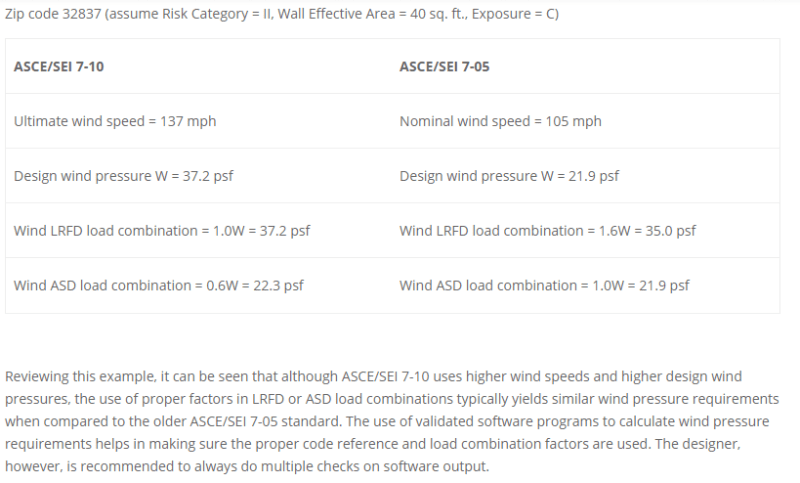Navigation
Install the app
How to install the app on iOS
Follow along with the video below to see how to install our site as a web app on your home screen.
Note: This feature may not be available in some browsers.
More options
Style variation
-
Congratulations cowski on being selected by the Eng-Tips community for having the most helpful posts in the forums last week. Way to Go!
You are using an out of date browser. It may not display this or other websites correctly.
You should upgrade or use an alternative browser.
You should upgrade or use an alternative browser.
Safety Factor for Shallow Foundation Uplift 4
- Thread starter NBRY1
- Start date
- Status
- Not open for further replies.
DaveAtkins
Structural
The ASCE load combinations include a combination with 0.6D. This load combination automatically gives you a factor of safety > 1.5 for wind load uplift.
DaveAtkins
DaveAtkins
- Thread starter
- #4
- Thread starter
- #5
If your foundation lift due to wind load combination, you must find a way to bring it down back to earth, either go deeper, increase footing size, or set foundation on pile. You shall check the governing code to find out safety factors factor for each case of stability. I think IBC covers that in section for design of foundation/substructures. For stability against flotation (uplift due to hydrostatic pressure), you might want to check USCOE design manuals.
-
2
- #7
DaveAtkins
Structural
The 0.6D load combination uses a reduced dead load which automatically results in a factor of safety of 1/0.6 = 1.67. No additional checks of factor of safety against uplift are required.
DaveAtkins
DaveAtkins
- Thread starter
- #8
Dave,
How does a code for 'load combinations' which includes factors that account for uncertainties in 'loads combinations' account for uncertainties in soil behavior.
Not saying you are wrong, simply do not understand justification to say load factors account for soil uncertainties and uplift factor is safety is entirely accounted for in load combination uncertainties.
Seems odd??
How does a code for 'load combinations' which includes factors that account for uncertainties in 'loads combinations' account for uncertainties in soil behavior.
Not saying you are wrong, simply do not understand justification to say load factors account for soil uncertainties and uplift factor is safety is entirely accounted for in load combination uncertainties.
Seems odd??
-
1
- #9
DaveAtkins
Structural
NBRY1,
I do not understand your question about uncertainties in soil behavior. I thought you were asking about the factor of safety against uplift, which has nothing to do with soil behavior. Just dead load versus wind load uplift.
DaveAtkins
I do not understand your question about uncertainties in soil behavior. I thought you were asking about the factor of safety against uplift, which has nothing to do with soil behavior. Just dead load versus wind load uplift.
DaveAtkins
- Thread starter
- #10
I do have question on the uplift safety factor provided by the 0.6D combination, at least the code is very unclear on this aspect. Let's exam the load combinations below and the comment:
ASCE7-10
Factored load combination U = 0.9D + 1.0W
Allowable load combination U = 0.6D + 0.6W
UBC97
Factored load combination U = 0.9D + 1.3W
Allowable load combination U = 1.0D + 1.0W
All I can say is - be conservative when use ASCE7 ASD combination, unless using the unspecified load combination, 0.6D+1.0W.
According to ASCE7-10 section 2.3.2, buildings and other structures, components, and foundation shall be designed so that their design strength equals or exceeds the effects of the factored loads....[Strength=Stability?]
ASCE7-10
Factored load combination U = 0.9D + 1.0W
Allowable load combination U = 0.6D + 0.6W
UBC97
Factored load combination U = 0.9D + 1.3W
Allowable load combination U = 1.0D + 1.0W
All I can say is - be conservative when use ASCE7 ASD combination, unless using the unspecified load combination, 0.6D+1.0W.
-
1
- #12
Lomarandil
Structural
Dave is entirely correct about ASCE's use of the 0.6DL factor to 'force' a factor of safety of 1.5 against global stability failure modes like uplift and overturning. Other codes use a 0.9DL factor, and require the 1.5 factor of safety separately (which is nice for checking members like a building beam where the global stability mode is not at play, but confusing otherwise).
NBRY1 -- perhaps some of the disconnect is the difference between the uplift failure mode and the overturning failure mode? As Dave said, when considering uplift, typically no soil 'behavior' is considered, only the weight of soil (which can be known with pretty good accuracy).
Retired -- that muddies the water a bit, because of the difference in wind load philosophy starting with ASCE 7-10, when wind loads are now expressed at ultimate/strength/500 year levels instead of the previous service/50 year levels used in ASCE 7-05 and UBC. As such, the ASCE combination and UBC combination result in the same wind load effect, although ASCE 7-10 applies that 1.5 factor of safety by decreasing the dead load, while I suspect UBC requires that factor of safety separately.
All of this discussion assumes (as is typically the case) that dead load is beneficial to the stability of the structure)
----
just call me Lo.
NBRY1 -- perhaps some of the disconnect is the difference between the uplift failure mode and the overturning failure mode? As Dave said, when considering uplift, typically no soil 'behavior' is considered, only the weight of soil (which can be known with pretty good accuracy).
Retired -- that muddies the water a bit, because of the difference in wind load philosophy starting with ASCE 7-10, when wind loads are now expressed at ultimate/strength/500 year levels instead of the previous service/50 year levels used in ASCE 7-05 and UBC. As such, the ASCE combination and UBC combination result in the same wind load effect, although ASCE 7-10 applies that 1.5 factor of safety by decreasing the dead load, while I suspect UBC requires that factor of safety separately.
All of this discussion assumes (as is typically the case) that dead load is beneficial to the stability of the structure)
----
just call me Lo.
ASCE7-10 has redraw the wind map. but did not result in 50% increase in wind pressures that would justify the lower of safety factor from 1.5 to 1.0. [incorrect statement] See presentation below for changes, and comparison of 2010 & 2005.
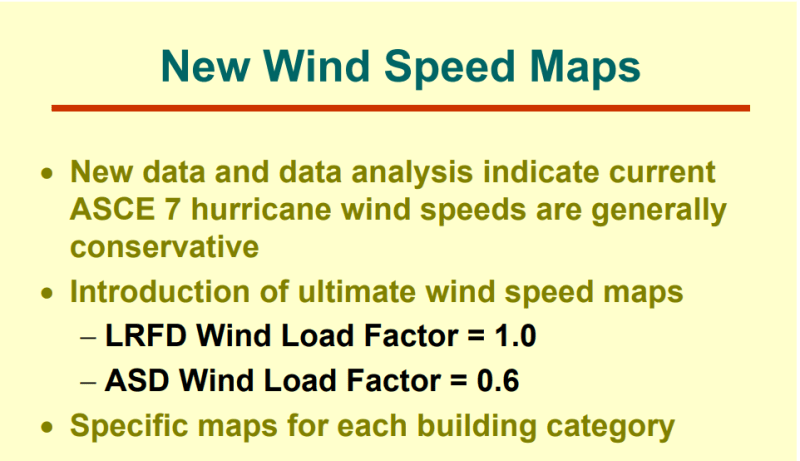
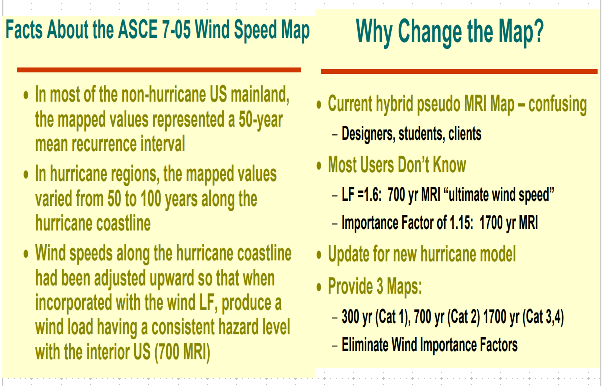
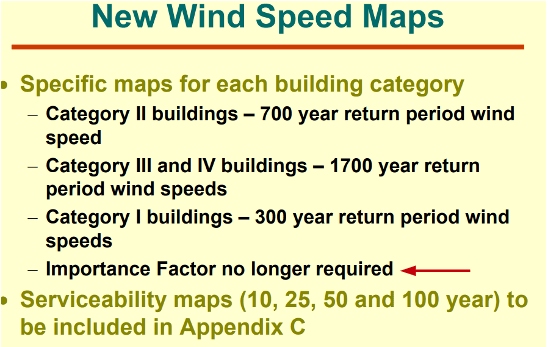
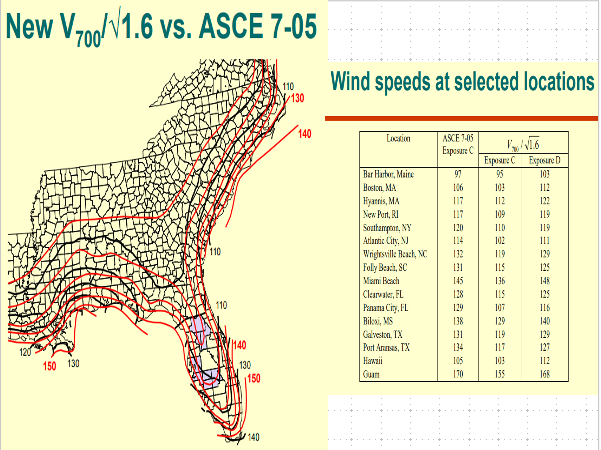
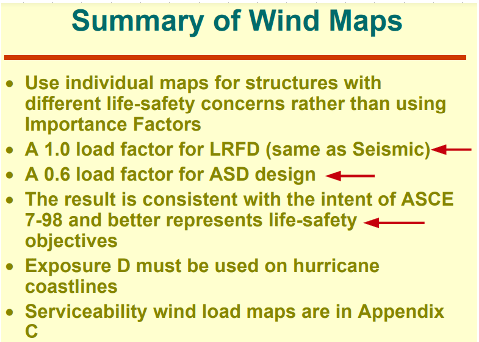
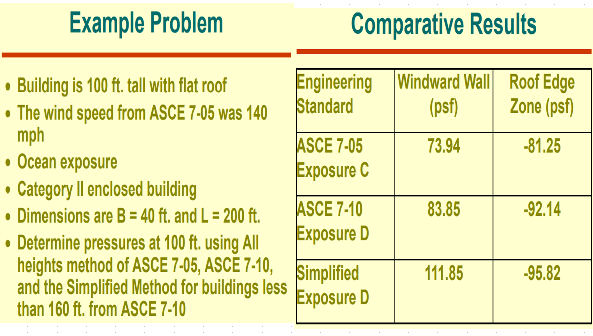






Lomarandil
Structural
Yes, as I said, same wind effect.
----
just call me Lo.
----
just call me Lo.
retired - you're comparing LRFD dead load factor for uplift in 7-05 and the ASD dead load factor for uplift in 7-10.
For ASD, 7-05 combination is 0.6D+1.0W (with W calculated at a 50 year MRI) and 7-10 combination is 0.6D+0.6W (with W calculated at a 700 year MRI). The end result is essentially the same, and both yield a factor of safety of 1.67.
As for the question of soil: if anything, ignoring the soil behavior is conservative. You can consider the weight of the soil above the footing in your dead load, but if you look strictly at dead load and wind uplift, you're ignoring any shear strength between the soil above and next to the footing. I live and practice in an area with very shallow frost depths, so our footings are regularly within the top 2' of the soil. So I usually ignore the presence of the soil completely.
For ASD, 7-05 combination is 0.6D+1.0W (with W calculated at a 50 year MRI) and 7-10 combination is 0.6D+0.6W (with W calculated at a 700 year MRI). The end result is essentially the same, and both yield a factor of safety of 1.67.
As for the question of soil: if anything, ignoring the soil behavior is conservative. You can consider the weight of the soil above the footing in your dead load, but if you look strictly at dead load and wind uplift, you're ignoring any shear strength between the soil above and next to the footing. I live and practice in an area with very shallow frost depths, so our footings are regularly within the top 2' of the soil. So I usually ignore the presence of the soil completely.
phamENG,
Good catch. Below is the revised sentence.
"1.5 FS does not apply to ASCE7-10 wind provisions, nor previous editions since 7-98, which had reduced the dead load factor from 1.0 to 0.6. I don't believe there was drastic change in wind load until 7-10."
Good catch. Below is the revised sentence.
"1.5 FS does not apply to ASCE7-10 wind provisions, nor previous editions since 7-98, which had reduced the dead load factor from 1.0 to 0.6. I don't believe there was drastic change in wind load until 7-10."
- Status
- Not open for further replies.
Similar threads
- Question
- Replies
- 2
- Views
- 2K
- Replies
- 2
- Views
- 3K
- Replies
- 3
- Views
- 1K

